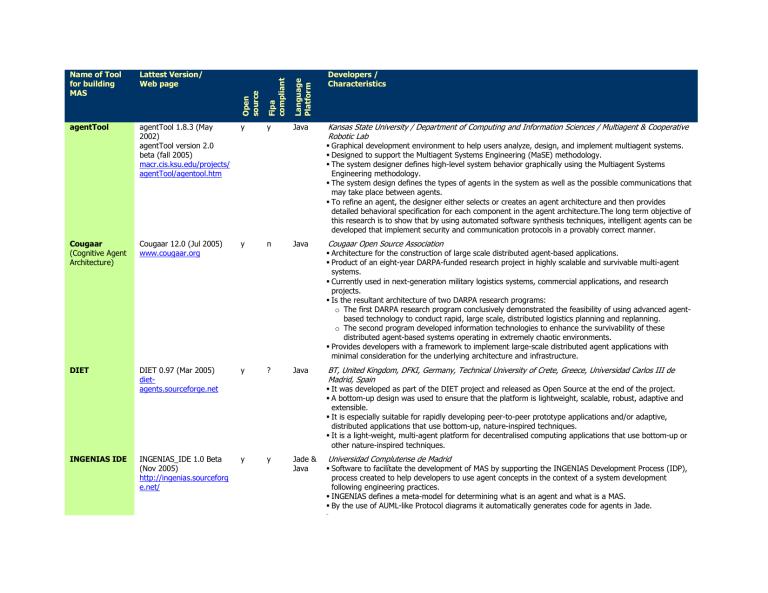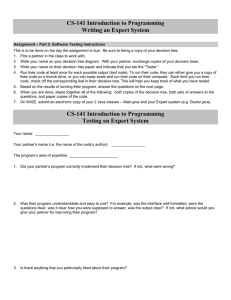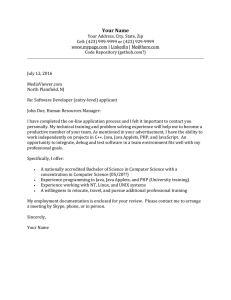Name of Tool Lattest Version/ Developers / for building

Name of Tool for building
MAS
Lattest Version/
Web page
Developers /
Characteristics agentTool
Cougaar
(Cognitive Agent
Architecture)
DIET agentTool 1.8.3 (May
2002) agentTool version 2.0 beta (fall 2005) macr.cis.ksu.edu/projects/ agentTool/agentool.htm
Cougaar 12.0 (Jul 2005) www.cougaar.org
DIET 0.97 (Mar 2005) dietagents.sourceforge.net
INGENIAS IDE INGENIAS_IDE 1.0 Beta
(Nov 2005) http://ingenias.sourceforg
e.net/ y y n y ? y y y
Java
Java
Java
Jade &
Java
Kansas State University / Department of Computing and Information Sciences / Multiagent & Cooperative
Robotic Lab
Graphical development environment to help users analyze, design, and implement multiagent systems.
Designed to support the Multiagent Systems Engineering (MaSE) methodology.
The system designer defines high-level system behavior graphically using the Multiagent Systems
Engineering methodology.
The system design defines the types of agents in the system as well as the possible communications that may take place between agents.
To refine an agent, the designer either selects or creates an agent architecture and then provides detailed behavioral specification for each component in the agent architecture.The long term objective of this research is to show that by using automated software synthesis techniques, intelligent agents can be developed that implement security and communication protocols in a provably correct manner.
Cougaar Open Source Association
Architecture for the construction of large scale distributed agent-based applications.
Product of an eight-year DARPA-funded research project in highly scalable and survivable multi-agent systems.
Currently used in next-generation military logistics systems, commercial applications, and research projects.
Is the resultant architecture of two DARPA research programs: o The first DARPA research program conclusively demonstrated the feasibility of using advanced agentbased technology to conduct rapid, large scale, distributed logistics planning and replanning. o The second program developed information technologies to enhance the survivability of these distributed agent-based systems operating in extremely chaotic environments.
Provides developers with a framework to implement large-scale distributed agent applications with minimal consideration for the underlying architecture and infrastructure.
BT, United Kingdom, DFKI, Germany, Technical University of Crete, Greece, Universidad Carlos III de
Madrid, Spain
It was developed as part of the DIET project and released as Open Source at the end of the project.
A bottom-up design was used to ensure that the platform is lightweight, scalable, robust, adaptive and extensible.
It is especially suitable for rapidly developing peer-to-peer prototype applications and/or adaptive, distributed applications that use bottom-up, nature-inspired techniques.
It is a light-weight, multi-agent platform for decentralised computing applications that use bottom-up or other nature-inspired techniques.
Universidad Complutense de Madrid
Software to facilítate the development of MAS by supporting the INGENIAS Development Process (IDP), process created to help developers to use agent concepts in the context of a system development following engineering practices.
_
INGENIAS defines a meta-model for determining what is an agent and what is a MAS.
By the use of AUML-like Protocol diagrams it automatically generates code for agents in Jade.
JADE
(Java Agent
DEvelopment
Framework)
JADEX
BDI Agent
System
JASON
Jacomma
(Java
Communicating
Agents)
Madkit
Jade 3.3 (Mar 2005) jade.tilab.com/ y y
Jadex 0.941 vsis-www.informatik.unihamburg.de/projects/jade x y
Jason 8 (Jan 2006) jason.sourceforge.net/
Jacomma 0.9.1 (Oct
2000) jacomma.sourceforge.net/
Madkit 4.1.2 (Nov 2005) www.madkit.org
y y y y y
? n
Java
Java
XML/
Jade
Arch
Java
Java
Java
Telecom Lab Italia
It simplifies the implementation of multi-agent systems through a middle-ware that supports the debugging and deployment phases.
The agent platform can be distributed across machines (which not even need to share the same OS) and the configuration can be controlled via a remote GUI.
The configuration can be even changed at run-time by moving agents from one machine to another when required.
Since May 2003, a JADE Board has been created that supervisions the management of the JADE Project.
Currently the JADE Board lists five members: TILAB, Motorola, Whitestein Technologies AG., Profactor
GmbH, and France Telecom R&D.
Distributed Systems and Information Systems Group at the University of Hamburg
Jadex stands for "JADE extension" and represents a Belief Desire Intention (BDI) extension for the JADE multi-agent platform.
It allows the usage of higher-level agent concepts for implementing agents.
The reasoning engine has been put into practice in the context of several research, teaching, and industrial application scenarios some of which are described on their webpage.
Facilitates easy intelligent agent construction with sound software engineering foundations.
It allows for programming intelligent software agents in XML and Java and can be deployed on different kinds of middleware such as JADE.
It is necessary to provide an agent architecture that at least takes into account agent-internal, agent society and artificial intelligence (AI) concepts.
Jomi Fred Hübner Universidade Regional de Blumenau Departamento de Sistemas e Computação and Rafael H. Bordini, Department of Computer Science University of Durham
Jason implements the operational semantics of AgentSpeak a BDI logic programming language extensively discussed in the literature.
The type of agents specified with AgentSpeak(L) are sometimes referred to as reactive planning systems.
A Jason multi-agent system can be distributed over a network effortlessly.
Features: strong negation, handling of plan failures, the possibility to run a multi-agent system distributed over a network, fully customizable selection functions, trust functions, and overall agent architecture (perception, belief-revision, inter-agent communication, and acting).
Just created (Jan 2004) with few applications running; however, it is based on a model from a project where M. Wooldridge, one of the pioneers in MAS participated.
Department of Computing, Imperial College of Science, Technology, and Medicine, at London, UK
Jacomma is an agent development platform/framework for developing distributed, mobile, and reactive information agents with heterogeneous communication capabilities, in Java and Jpython.
It provides a development framework and an execution environment, which sits on top of the Inter-
Agent Communication Model infrastructure. The ICM defines a communication protocol, a store and forward messaging architecture, and low level communication infrastructure for message exchange.
The MadKit Team
Some features are introduced that make this platform specially suitable for symbolic/connectionist hybridization.
A modular and scalable multiagent platform built upon the AGR (Agent/Group/Role) organizational model: agents are situated in groups and play roles.
It allows high heterogeneity in agent architectures and communication languages, and various customizations.
Its communication is based on a peer to peer mechanism.
MAST
(MultiAgent
Systems Tool)
OpenCybele
Quicksilver 23 www.gsi.dit.upm.es/~mas t/
OpenCybele v1.2 www.opencybele.org
May 2005 quicksilver.tigris.org/
? y y n y n
Zeus Agent
Building
Toolkit
ZeusAgent 2.0 patch 2
(Jan 2006) labs.bt.com/projects/agen ts/zeus/ y
For more details and updates visit www.multiagent.com
n
C++
Java
Java
Java
Agents in MadKit may be programmed in Java, Scheme (Kawa), Jess (rule based engine) or BeanShell.
Departamento de Ingeniería de Sistemas Telemáticos / ETS de Ingenieros de Telecomunicación /
Universidad Politécnica de Madrid
With the MAST project in mind, a specialized language (Agent Description Language, MAST-ADL) has been designed to simplify the specification of the agents cooperating in solving a problem in a hybrid framework.
It has been conceived as a general purpose distributed framework for the cooperation of multiple heterogeneous agents.
Some features are introduced that make this platform specially suitable for symbolic/connectionist hybridization.
The MAST architecture consists of two basic entities: the agents and the network through which they interact. The basic functionalities and interfaces of the network constitute the network model.
Several communication primitives are implemented, including different synchronization mechanisms
(synchronous, asynchronous and deferred communications) and higher level protocols, as Contract Net.
Intelligent Automation Inc.
It is the open source release of the Cybele(TM) agent infrastructure
It is a runtime environment built on the top of the Java 2 platform for control and execution of agents.
It adopts a service-layered architecture promoting plug-n-play capability of agent services, such as,
Concurrency management, Event management, Communication and Timer event generation.
It also promotes an Activity Centric Programming (ACP) paradigm for coding agents. The ACP paradigm encourages encapsulation of the agent's autonomous behavior as a group of activities. The activities can be coded using the core Activity Oriented Programming Interfaces (AOPIs) that are provided as a part of the OpenCybele kernel.
Other features include location independent communication, publish-subscribe based messaging, synchronous, asynchronous, broadcast, and point-to-point messaging.
Tigris.org, a mid-sized open source community and XLOG Switzerland
The goal of quicksilver is to provide a simple environment that allows the quick development and testing of agent models.
Quicksilver cooperates with the Java environment in that it delegates the development of agent types and viewers to Java.
Agent models can be run as Applets or MIDlets.
_
Applications include Decision Support, Multiplayer Games, Information Agents, etc.
BT Communications
It was one of the first and most relevant agent toolkits and by the days of its first release provided a synthesis of established agent technologies with some novel solutions that deployed an integrated environment for the rapid development of collaborative agent applications.




